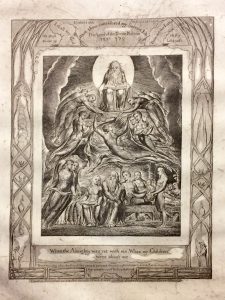
One of William Blake’s illustrations of the Book of Job, pulled from the McGill plate by Miss Van Hoogandycke, 1969. RBSC (Lande Blake Collection), Blake 5.2 B64T57 1969 elf.
William Blake (1757–1827), English painter and poet, made his living as a commercial engraver and was best known for that work during his lifetime. He was later recognized for his original work as an artist and poet, which included lyrical compositions of spiritual imagery inspired by his interest in theology and philosophy, and an innovative method of “illuminated printing” that combined text and image on a single copperplate.
McGill’s Blake Collection was established in 1953 with a donation of some 250 items by Dr. Lawrence Lande (1906–1998), a major Canadian collector and bibliographer. It has grown to include more than a thousand monographs, facsimiles, engravings, drawings, and slides. Editions of Blake’s own literary works are here, as are copies of books in the editions owned or read by him.
Blake’s professional work is well represented here with copies of almost all of the books he illustrated as an engraver. Among these are early and variant editions of non-fiction works like the Narrative, of a Five Years’ Expedition Against the Revolted Negroes of Surinam… by John Stedman, and also literature, such as Robert Blair’s poem, The Grave, or Edward Young’s The Complaint, and the Consolation. Blake’s greatly admired illustrations of Dante’s Divine Comedy and the Book of Job can be consulted in large individual leaves for side-by-side study, as well as in bound editions. The Book of Job illustrations are complemented by three engraved copperplates, possibly manufactured by a photographic process for an unfinished edition; a print pulled from one of these is shown here.
Blake’s friends and followers are represented with works by Swiss artist and writer Henry Fuseli, and English painter and printmaker Edward Calvert, among others. The basis of a rift between Blake and fellow-artist Thomas Stothard regarding credit for the conception of the scene to accompany Chaucer’s Canterbury Pilgrims can be viewed through engravings from the paintings of both Stothard and Blake of this scene. Many of Blake’s illustrated poems and paintings are also present in facsimile copy, most notably by the Parisian Trianon Press, famous for their high quality reproductions, those of Blake in particular.
Books with illustrations by Blake are also held in other collections, namely the Osler Library of the History of Medicine and the Blackader-Lauterman Collection of Architecture and Art. The William Colgate History of Printing Collection provides further examples of printmaking and books by Trianon and Chiswick Press, the latter of which was a pioneer of the nineteenth-century fine press movement in England, and also figures in the Blake Collection. McGill’s Prints Collection and the Woodblock Collection will also be of interest to researchers in art history and book illustration; additional perspectives on Lande as a collector can be explored by consulting the Lawrence Lande Collection of Canadiana.
*This text originally appeared in the McGill Library and Archives publication, Meetings with books : special collections in the 21st century with a tribute to Raymond Klibansky & illustrated survey of special collections at McGill University Library and Archives (2014). The book is freely available online or for purchase as a print volume.
